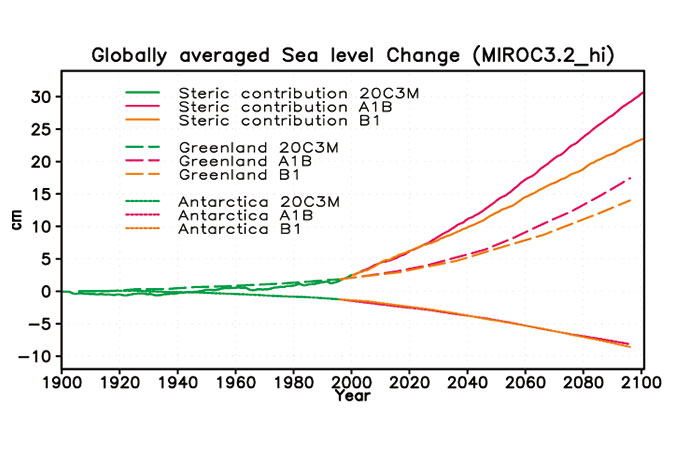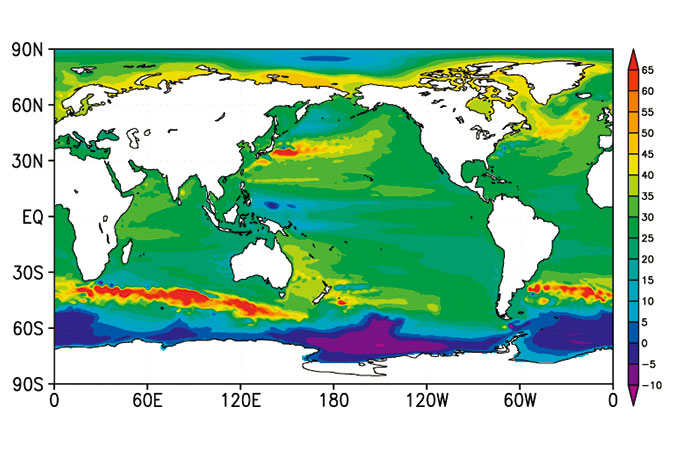UTokyo researchers answer questions on 21 GX (Green Transformation) topics from their specialist viewpoints. Through questions that cannot simply be brushed off as someone else’s concerns, take a peek into GX and our world of research.
Q15. Is it true that Japan will be submerged if the polar ice melts?
Sea levels are rising due to global warming. If nothing is done, will Japan disappear beneath the waves in the coming 100 years?Answered by Hiroyasu Hasumi
Professor, Atmosphere and Ocean Research Institute
Physical Oceanography

Sea level rises are due to melting ice and thermal expansion

There are various predictions about what will happen in the next 100 years, but none of them see the whole of Japan being submerged as a likely event. However, the sea might encroach into some low-lying areas. Land lying at sea level already exists, and in that case, such areas would increase. If global warming gets even worse and causes all the Antarctic ice to melt, the entire ocean will rise by more than 100 meters, enough to completely submerge the Japanese plains.
Sea levels have continued to rise since the Industrial Revolution, with a report from the Intergovernmental Panel on Climate Change (IPCC) stating that the average sea level on Earth increased by 16 centimeters in the period from 1902 to 2010. One of the major causes is the melting of sheet ice and mountain glaciers in the Antarctic and Greenland, but about half the rise in sea level comes from thermal expansion — the increase in water volume as the sea gets warmer. According to our simulated forecasts, we think that the effect of thermal expansion on sea levels will continue in the future to be roughly similar to that from the melting ice sheets. For instance, if the temperature of the topmost 100 meters of the sea increases by 1°C, the sea level will rise by one centimeter. This means that if the sea temperature rises by 2°C to 3°C by the end of this century, it would not be unusual for the effect of thermal expansion alone to result in a 20- to 30-centimeter increase in sea level, since in reality, slightly deeper water is affected by the sea temperature rises. Such an increase would be sufficient to flood places that don’t have seawalls or other such structures in place, such as the low-lying areas along both sides of the Arakawa River in Tokyo.
Westerly winds cause a higher water level in some places
Melting ice sheets and thermal expansion make the local sea levels rise, after which it takes about 10 years for the increase in water level to spread out across the entire ocean. The surface of the sea is not level but undulates by +/- one to two meters due to the effect of wind-induced ocean circulation. In the Pacific Ocean near Japan, for example, the water level at latitudes 30 degrees north is about one meter higher than the average sea level of the ocean, but the level close to the South Pole is two meters lower. Global warming is thought to be making the westerly winds stronger and affecting the undulation of the sea surface, so it is even forecast that the already high sea level of the Pacific around Japan’s southern coasts will get higher and the already low sea level around the South Pole will drop further. The key to preventing this situation is to keep the water temperature from rising, and to do so, the rise in air temperature must be stopped.
I have been researching deep-ocean circulation systems for many years. Ocean currents also exist in the deeper sea, and circulate throughout the ocean, both horizontally and vertically, connecting the deeper layers with the shallow. When sea water moves to higher latitudes it gets colder and the resultant increase in density, also influenced by changes in salt content, causes it to sink. After moving around from place to place, this water gradually climbs to the surface of the sea at lower latitudes, cooling the surface from below. One of the big topics in global warming forecasting right now is the idea that this type of circulation system, cooling the sea at low latitudes and warming it at higher latitudes, is weakened by global warming and even exerts an impact on our climate. I want to know how humans are affected by changes to the sea in general, including this deep-ocean circulation, and am trying to develop methods that accurately simulate the sea.


* This article was originally printed in Tansei 46 (Japanese language only). All information in this article is as of March 2023.







